For this exercise we were to produce a short sequence in which two people are communicating across an off-screen space. It was not allowed to use a wide shot because the idea was to create the impression of the off-screen space through the composition of the shots.
Here is the script, with some modifications:
- Robin is in the garden. He is weeding the overgrown flowerbed (well I had to get him to do it somehow!) He is focused on what he is doing.
- Kestrel is sitting a few metres away at the top of the garden cuddling her rabbit. She notices her dad weeding but looks away.
- Robin looks up for a moment and notices Kestrel. He reacts with curiosity as to why she is so quiet.
- He continues to look at Kestrel.
- Kestrel becomes aware that her dad is looking at her and looks up at him.
- Robin smiles at Kestrel.
- Kestrel gets up and walks to her dad.
In this exchange, I wanted to try to capture the understated fondness of the relationship between a father and his daughter. This is the age where a young girl can be a bit more restrained with her affection and the father needs to be sensitive to this change. This does not however mean that they are not close, just that the affection they display is a bit more hidden and subtle.
When filming this, I made sure that Robin was away occupying the right side of the frame and Kestrel the left. It was a fairly dull and cloudy day, so both the actors wore bright coloured shirts so that they stood out from their surrounding. I also wanted the scene to be quiet but positive and the bright colours helped.
During the filming, I realized that there were a number of occasions where I was breaking the 180 degree rule. The 180 degree rule states that when you are filming two characters who are in the same scene, they should always have the same left/right relationship with each other so that the audience does not get confused about the orientation of actors. To use this rule, an imaginary line is drawn between the two actors. When filming, the camera should always stay on one side of this line.
I realised the mistake I was making at the time and was able to adjust and get more footage that respected the 180 degree rule. The result is the video exercise above. However, I was curious as to what the video would look like if I cross the 180 degree line – would it be very confusing? So I put the footage together, and this was the result.
I must admit that it is mildly confusing but I was still able to follow the action easily. This is probably due to the set up being rather simple and the action very slow. In some ways, I felt that this second attempt was more dynamic even though it broke the rules.
Other students:
I have only managed to find one other exercise like this that has been completed by another student. Chloe has done a very different theme to mine.
The communication between her two characters is more dramatic; the emotions being expressed are shock and fear in the case of the girl and a very ambiguous emotion in the case of the man (either amused or a bit sinister) which I rather enjoyed.
The framing has made clear where the characters are in relation to each other and the choice of shot provides enough information for the viewer to recognize that this is taking place in a garden; presumably the girl’s home, since see is very comfortable in her seat at the start of the video.
Examples of off screen space:
A the beginning of the movie Cold Mountain, which takes place during the American Civil war, the scene is the Siege of Petersburg where the Yankees get themselves trapped in a hole that they earlier had blown up with dynamite. The space between the Yankees and the Confederates is off screen as the build up to this confrontation occurs.
At first, you see a young boy, covered in blood, climb up from the devastation of the dynamite explosion that has just occurred; there is smoke and fire everywhere. He looks into the distance. The next shot is of the approaching army emerging from the smoke, though at this stage you are not able to see the hole they are about to run themselves into. As the two groups get closer to each other, the off screen space closes progressively until it become apparent that the Yankees have run into a hole and the Confederates can now stand at the top of the trench and simply shoot at them.
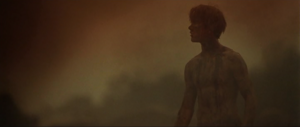
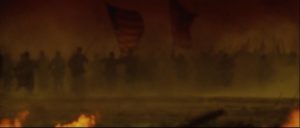
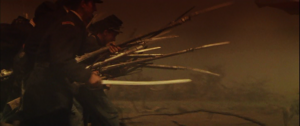
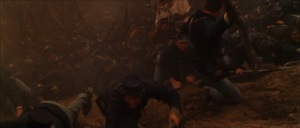
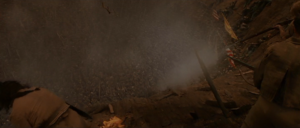
In one of the opening prison scenes of The Shawshank Redemption, Red comes out of the building where his parole has been rejected again. He steps outside into what looks like a confined space, probably one of the prison courtyards. Red looks up to the off screen sky -‘the audience doesn’t sees the sky but is are aware that it must be there and that for Red it symbolizes a freedom he doesn’t not have. The audience is also not given the freedom to see that blue sky.
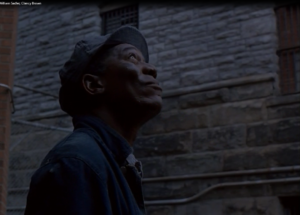
Later in the movie, the old librarian, Brooks, is granted parole however he has lived so long in the prison that the prospect of the outside and freedom is too frightening for him. Dressed in his smart clothes for leaving, he takes the black bird he has cared for since a chick and sets it free through the barred window – it flies where Brooks does not want to go. There is a shot of Brooks looking out of the window – he is in shadow and just his face is lit by the outside light. The off screen space is the outdoors, but this time it does not represent freedom, at least not for Brooks. The audience never sees this space but of course knows it is there. This is a complete reversal of the first example of the use of the off screen space for the same concept of freedom.
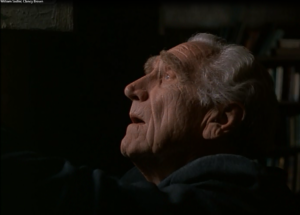
On the first night that Andy and the other new inmates arrive, there is a bet to see which of the ‘new fish’ will breakdown first. There is a series of shots between one of the new inmates and an old hand who is taunting him by trying to appear to comfort him. The shots alternate between medium close ups of both characters. The audience is not able to see the space between them, although they know that both are in separate cells they are not able to work out how far apart they are – at best it is possible to say that they are close enough to be able to speak. This separation emphasizes how it must feel for the new inmate – separated from any comfort, not able to see clearly and disorientated.
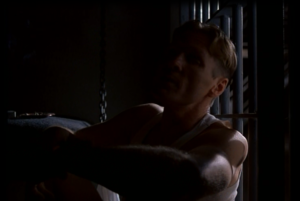
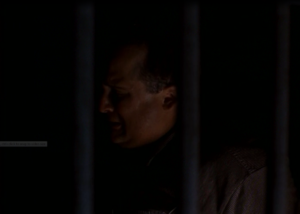
Filmography:
Cold Mountain [feature film, DVD] Dir. Anthony Mingella. Miramax, Mirage Enterprises, USA, 2003, 154 min.
The Shawshank Redemption [feature film, DVD] Dir. Frank Darabont. Castle Rock Entertainment, USA, 1994. 142 min.
